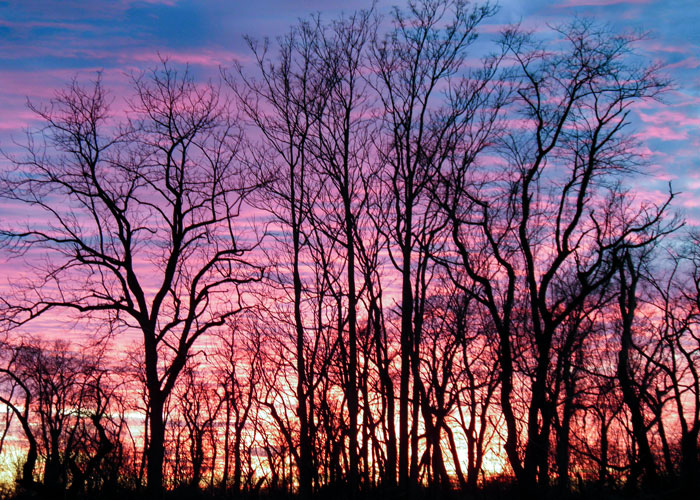
In 1803, John James Audubon came to America from France, at the age of eighteen. At his family’s 284-acre Pennsylvania homestead at Mill Grove, near Valley Forge, Audubon began to study birds in earnest, tying yarn to the legs of Eastern Pheobes in the first known bird-banding, creating his own nature museum, and honing the illustrating skills that would eventually elevate and forever link his name with ornithology and the conservation of avian life. In 1810, he ventured to the Kentucky frontier in search of a “real job” to support his family, but found the import-export trade difficult, frequently turning to hunting and fishing to feed his wife and children, while acquainting himself with all aspects of a pioneer’s proximity to nature. Eventually he returned to ornithology and painting, while his wife Lucy worked as a teacher to provide for their two young sons.

In 1826, Audubon took his impressive collection of scenes from the American frontier to England, where he found eager acceptance and was able to raise enough money to begin publishing the monumental work, Birds of America. The book, which cost the equivalent of two million of today’s dollars to print—paid for in advance by subscriptions, exhibitions, painting commissions and animal skins—contained over 700 North America species, 435 of which were depicted in hand-colored life-size prints. The work, regarded as the “greatest picture book ever produced,” became very popular with Europeans hungry for visions of the brave New World, and provided Audubon with sufficient fortune and fame to continue his career back in the United States until his death in 1851. His triumph over adversity, his pioneer eminence, and his artistic gifts are all part of the Audubon legend. But, today, in most people’s minds, the name Audubon has most to do with birds and, more generally, nature conservation.
John Audubon had no part in the organizations named for him, although one of the founders of the early Audubon Society in the late 1800s chose his name as the inspiration for the organization’s earliest work to protect birds and their habitats. The National Audubon Society, which currently consists of 500 chapters, was founded in 1905. But before that, independent groups formed to do vital local and regional work around the country. One of the oldest independent Audubon Societies was founded in 1897, in New Jersey. A privately supported, not-for profit, statewide membership (22,000 strong) organization, The New Jersey Audubon Society maintains stewardship of thirty-four sanctuaries and conducts its programs through seven staffed facilities around the state. The Cape May observatories bring thousands of birders from around the world, especially for the fall migrations. There are sanctuaries (Urban Oases), such as those in Linden, Franklin Lakes, Plainsboro and Petty’s Island. The Scherman Hoffman Sanctuary in Bernardsville hosts the magnificent Center for Conservation and Environmental Education, and serves as headquarters, administrating programs and events at all locations that foster environmental awareness and a conservation ethic.
NJ Audubon also goes about protecting birds, mammals, other animals, and plants—especially endangered and threatened species—by promoting the preservation of precious natural habitats, those that most resemble their native configurations. In the state most known and much maligned for its density and propensity for pavement, one that has borne four-hundred years of European industrial and agrarian adaptation, finding ways to avoid the further invasion of an area’s natural progression is tough enough. Actually restoring habitats whose indigenous forms have been long obliterated, while preserving their economic viability, takes persistent planning, ingenuity and perseverance. But it is in New Jersey that those solutions must be learned and developed. Unless we take a real bad turn for the worse, all of America will eventually have to confront our situation. NJ Audubon has taken some serious steps in that direction, notably in the ongoing partnership in the efforts at Duke Farms Living Habitats in Hillsborough. And, NJ Audubon’s thirty-fifth outpost, the Wattles Stewardship Center in Port Murray, is a model for blending environmental awareness, wildlife habitat, and agriculture.
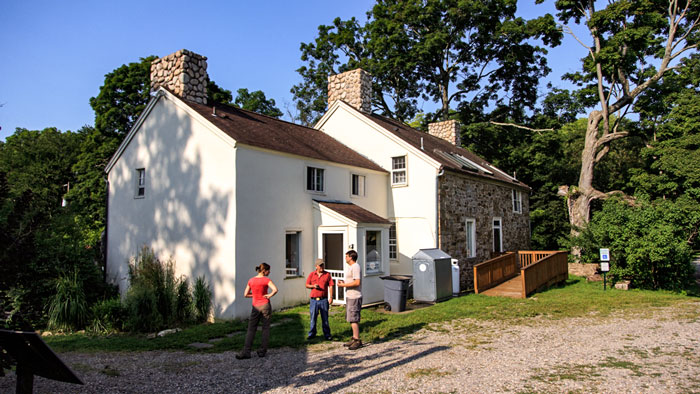
“Farmers are the stewards of the land,” says John Parke, Audubon’s Stewardship Project Director for Northern New Jersey. “It’s important that we work with them.” Parke works out of the Wattles Stewardship Center, which he helped establish in 2009. 352 acres were given to the State of New Jersey, Warren County and NJ Audubon by Gurdon Wattles, whose family once owned large tracts of land that extended from here on over the Musconetcong River well into Hunterdon County. The Warren County portion of the acreage has since been purchased, and is presently farmed, by the Donaldson family, long prominent in the agricultural community. Eighty-nine of the acres, mainly along the riverbank, is public state land for fishing, birding, hunting and general recreation. Fifty-two acres, which are Audubon’s, host a perfect old farmhouse, barn and garage that serve as home base for the Northern Region staff. Restored native habitats reign throughout the property, serving as models for sustainable farming; where farmers can come and see how progressive land management can help expand their inventory, without compromising productivity. The trails, woods and fields are also delightful places to walk, and you are heartily encouraged to do so!
Parke leads the way out of the yard past a small herd of sheep (there to “mow the lawn”), down towards the river. Before the main trail begins there is a vernal pool, reconstructed on the site of a former concrete swimming pool. Because vernal pools appear in natural depressions during the spring and gradually dry out over the summer, they are crucial to the survival of amphibians that can breed without the threat of hungry fish. The pond’s liner has been punctured sufficiently to allow proper drainage, and spring peepers, wood frogs, green frogs, spotted salamanders, and toads gallivant with only the occasional heron to fear. Surrounding the pond, native plants support a chorus of pollinating butterflies and bees.
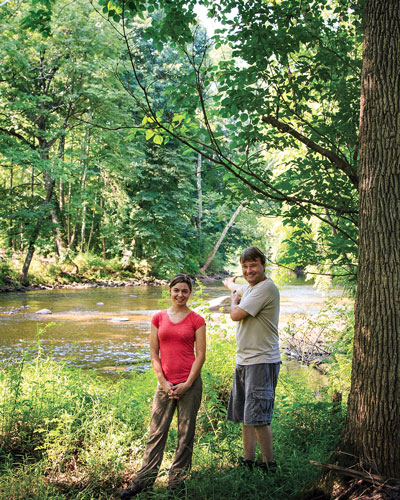
We approach the Musconetcong along a path bordered by a rotational crop and stream buffer. (In common man’s lingo, that would be a cornfield and a row of trees.) “We were doing a lot of work in northwest New Jersey with farmers,” explains Parke. “Even though we had stuff all over the state, Audubon didn’t have a presence out here. This is a little different. We have a model conservation farm with existing farmers working the land, and the opportunity to take advantage of NRCS (National Resource Conservation Service) and other farm service programs. The question is ‘How do you use these programs and still get good production out of your farmlands?’” John Parke is here for a reason; years ago he implemented a “Birding On Farms” program and has built an impeccable reputation among New Jersey conservation proponents and, at the same time, the traditional farming community, not always a comfortable alliance. He’s an environmental scientist who knows where the grants are and how to get them. (He’s also an accomplished photographer. Maybe, back in the day, he would have been a painter!) The Wattles Center operates under two farm service programs, two NRCS programs, a forest stewardship plan, and works with the US Fish and Wildlife service. With all these programs in place, there is still a farmer who works these fields and enjoys phenomenal production!
The state asked NJ Audubon to manage the land along the Musconetcong, so Parke applied for more NRCS funding to do stream restoration with Trout Unlimited, another of the Garden State’s leading conservation advocates. This mile-long stretch will be paradise for native brook trout, smallmouth bass, eels, mink, river otter, turtles and mussels. You’ll see more ducks, eagles and osprey. And the endangered brook snake-tail dragonfly will continue to breed here, one of the few colonies left in New Jersey. For the botanist, there is massive evidence of the invasive lesser celandine, brought here by the two recent “storm events”. The ground is covered with the plant’s tubers, which will explode next spring into a sea of yellow flowers, choking out all the native ephemeral plants that, up until four years ago, graced these banks. Still the riverside is peaceful and lovely, and a trail fork to the right soon invites us to continue across a bridge to the Point Mountain Reservation in Hunterdon County.
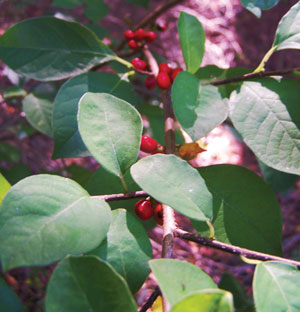
We bear left, back on Audubon property, and John points out a spicebush. The plant’s dark green oval leaves, similar to mountain laurel, were once commonplace in New Jersey’s forest understory, now commonly covered with the invasive multiflora rose. The fruits of spicebush, berries that turn a shiny red in autumn, are food for migratory birds, and for people. It is said that George Washington made tea from spicebush berries when his coffee supply ran low. And you’ll figure out how the plant was named when you investigate all the recipes for spiceberry seasonings!
We come upon a meadow, which not long ago was also covered with mulitflora rose and autumn olive. To manage these and other invasives, the field was mowed out—scraped to the ground—then mulched to prevent growth. The next spring, the field erupted in a burst of native plants, all from a previously inhibited seed bank waiting beneath the surface.
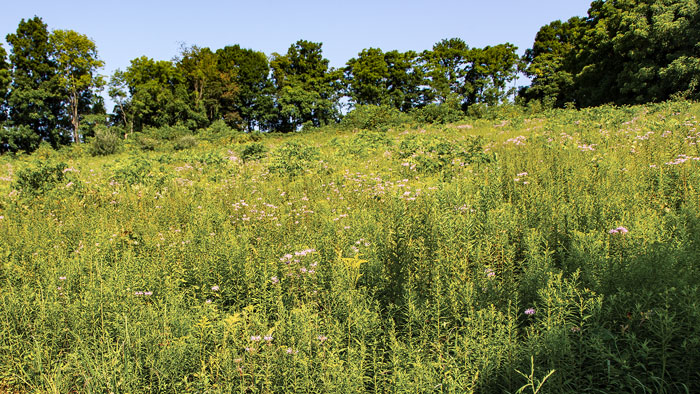
Now four years old, the meadow has entered it’s “early successional” stage, where it will remain as trees will not be allowed to grow up and block the light that sustains this environment. “This is for educational purposes,” explains John. “Most everything in New Jersey is either mature or mid-stage, but most of the threatened species need early successional surroundings. This field was a seed band for invasives, which farmers certainly don’t want. We turned it into a mighty pollinator.” The golden rod buzzes with bees and butterflies, and the meadow is alive with field sparrows, catbirds, rabbits and box turtles. You could sit here all day.
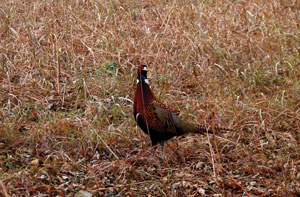
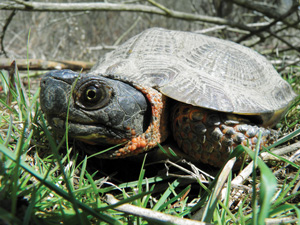
The trail leads to a large expanse of tall grass, another “show me” field for farmers. Funded in part by the State Acres for Wildlife Enhancement (SAFE) program this former cornfield, plagued with erosion problems, has been transformed. “The farmer gave up the field to plant these native warm season grasses,” says John. “This mix will peak in August and September, as opposed to horse hay that peaks in June. When hay gets cut, breeding birds get ousted. With these grasses the birds are gone by the time it is harvested.” These root systems go much deeper—six to ten feet below grade—and allow better water filtration and much less erosion. “A big bonus is that these are ‘C4 plants’; they absorb another molecule of carbon from the atmosphere. 95% of plants are C3s (absorb three molecules of carbon) so these sequester carbon back into the ground.” And there is a healthy local market for these grasses as a medium in which to grow mushrooms. The harvest is huge in biomass, forming giant bales that sell for $115 a ton. That’s a lot for hay, and this can pay better than a field of corn. “These grasses do carbon sequestration, erosion control, ground water filtration and habitat, and you make money,” Parke continues. “Its not traditional so it’s slow to come. But this program sets the farmer up. We bring the farmer to show the field, get the applications, help fill them out and bring them to NRCS. They will get rid of invasives, prep and seed the field.” C4s, C3s, whatever, this field is something to behold as the golden plumes of big blue stem, switch grass and Indian grass glow through the fall. And, needless-to-say, it’s a popular place for birds.
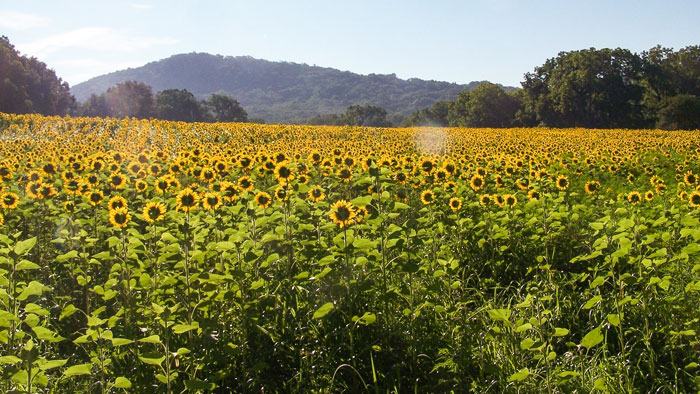
Open 8-5, seven days, the Wattles Stewardship Center is located at 1024 Anderson Road in Port Murray. Click or call 908/366-7781
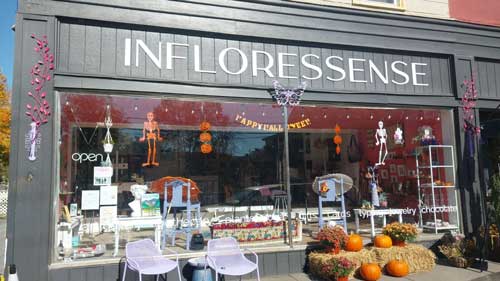
A fine art gallery like no other! Unique, handmade gifts and cards as well as yoga, meditation, and continued learning lectures. Come in Saturdays for all-day open mic and Sundays to try unique nootropic chocolate or mushroom coffee. Browse the $5 books in the Believe Book Nook while you nibble and sip.
The 8,461 acre park includes the 2500-acre Deer Lake Park, Waterloo Village, mountain bike and horseback trails.
Millbrook Village, part of the Delaware Water Gap National Recreation Area, is a re-created community of the 1800s where aspects of pioneer life are exhibited and occasionally demonstrated by skilled and dedicated docents throughout the village
Choose and Cut from 10,000 trees! Blue Spruce, Norway Spruce, White Pine, Scotch Pine Fraser Fir, Canaan fir, Douglas Fir. Family run on preserved farmland. Open Nov 29 - Dec 23, Tues-Sunday, 9-4. Easy Access from Routes 78 or 80.
Local roots!